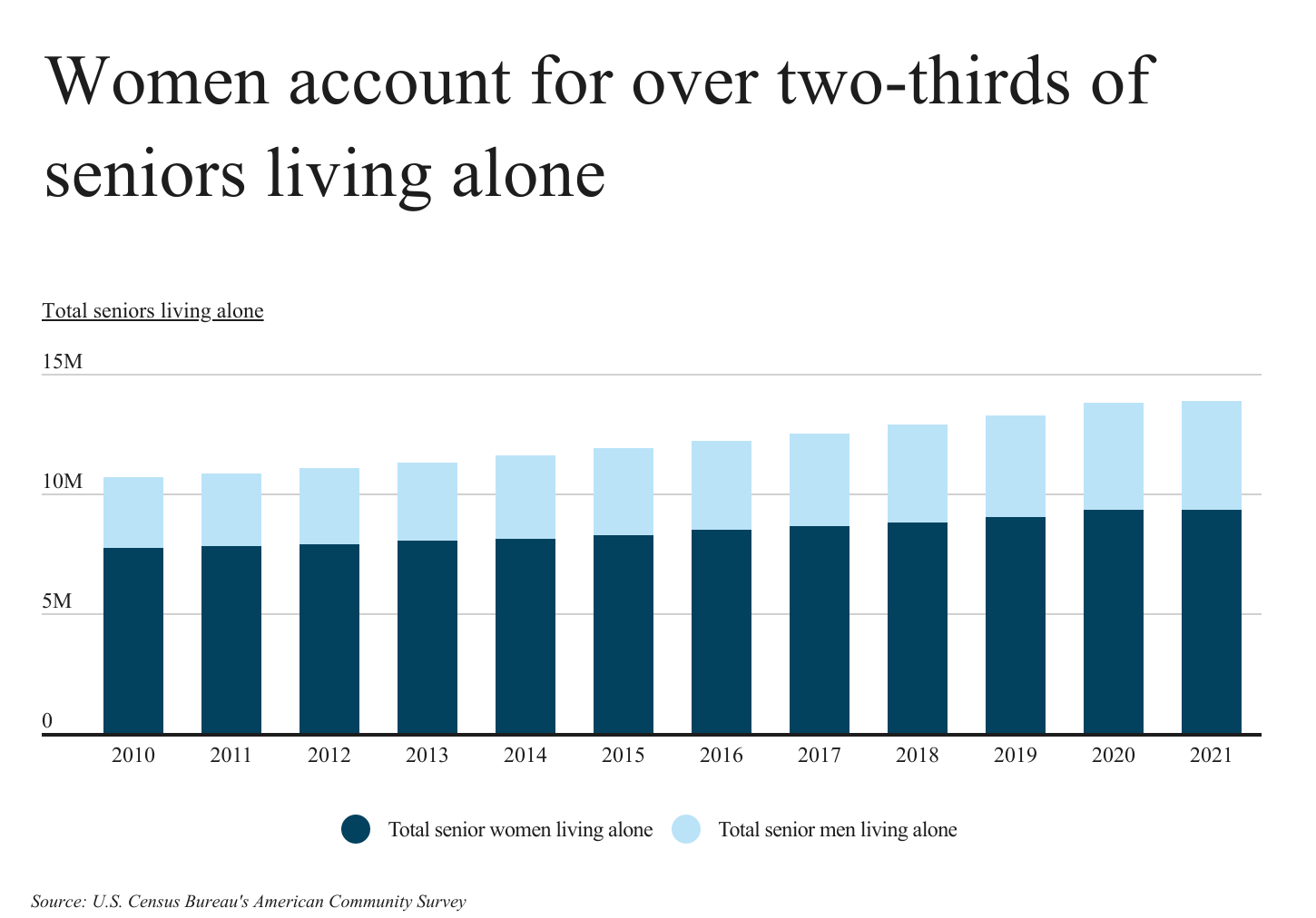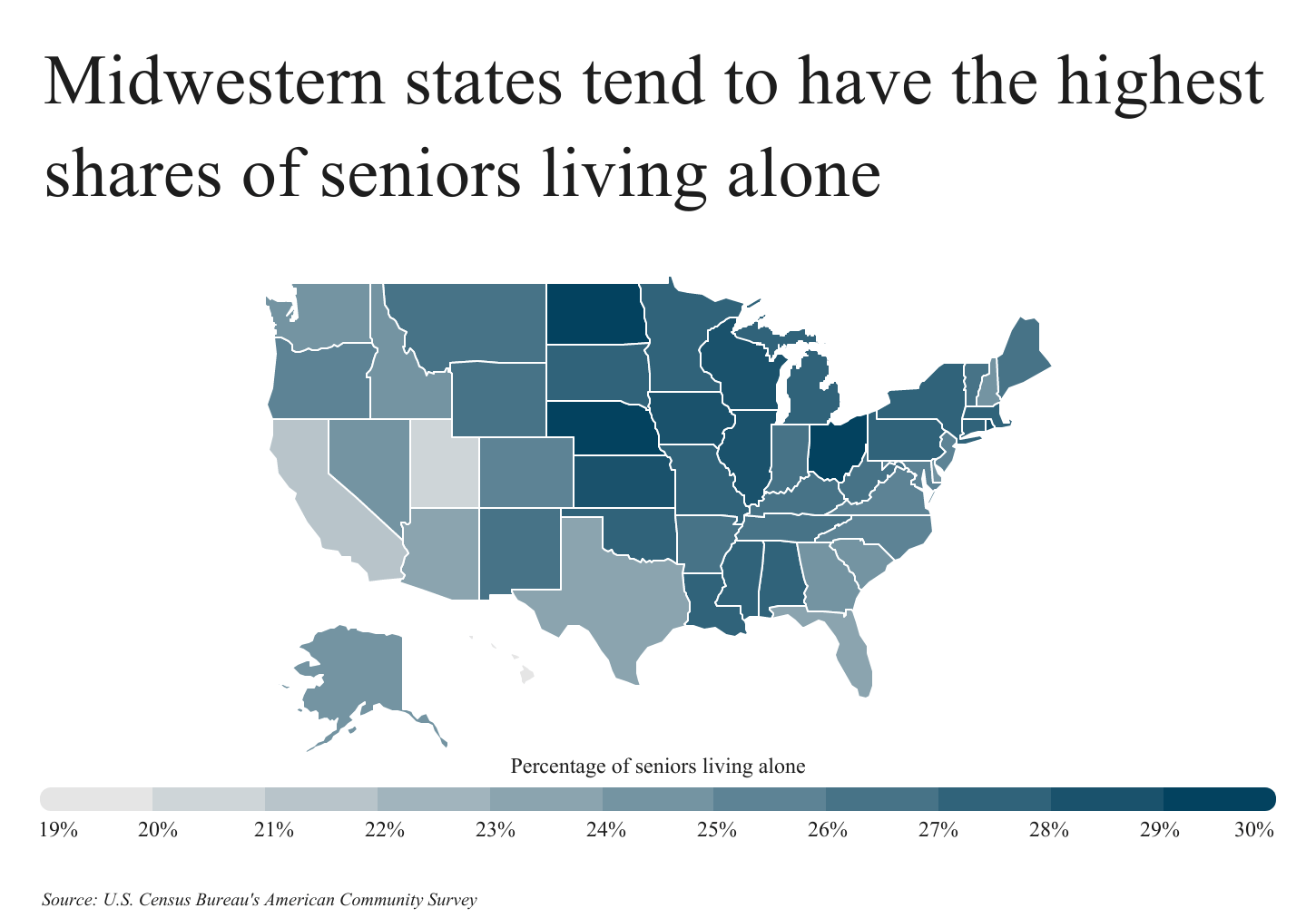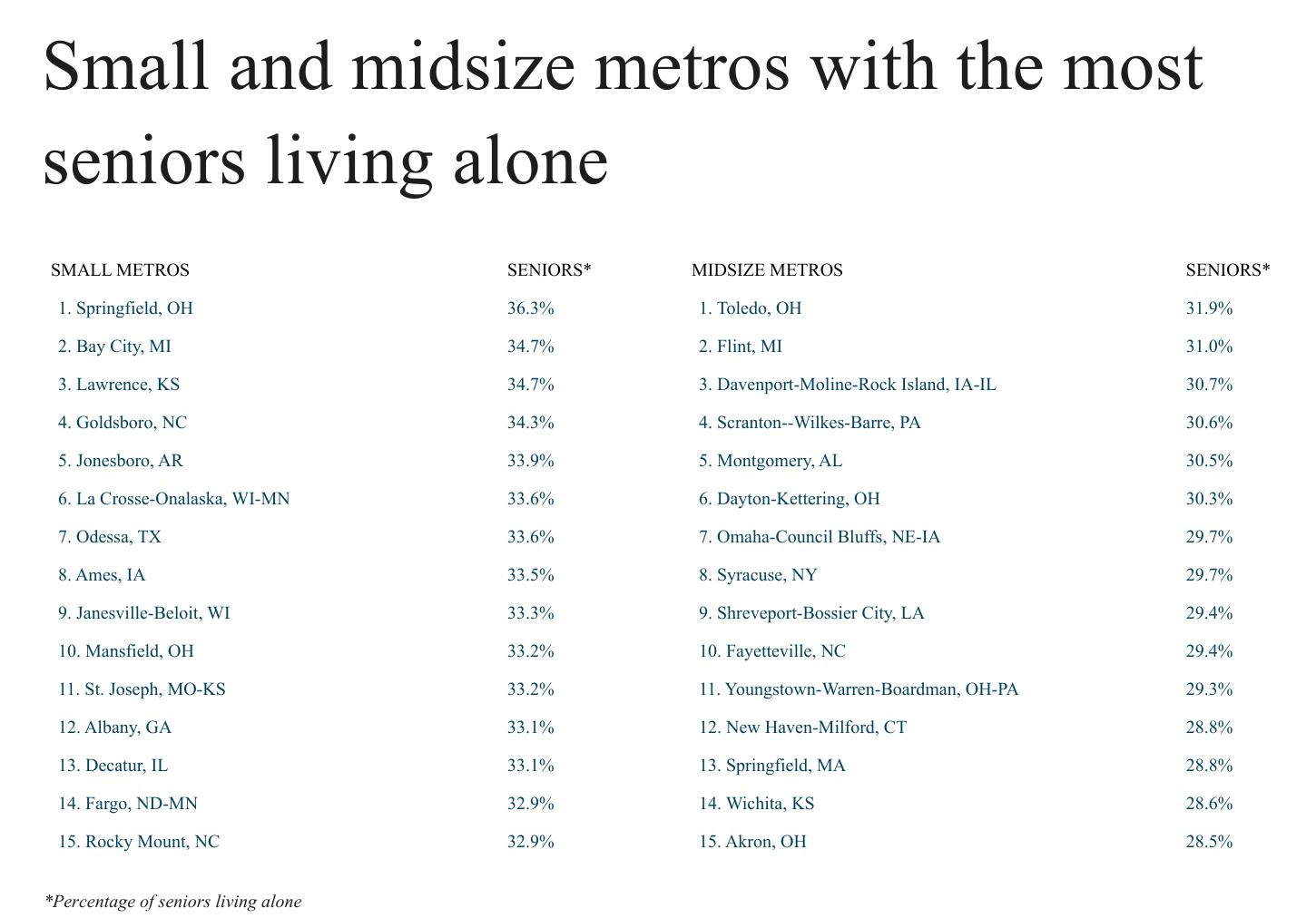United States Cities With the Highest Rates of Seniors Living Alone

Photo Credit: Solarisys / Shutterstock
Globally, living within an extended family household is the most common arrangement for seniors and older individuals. But in the United States, older people are actually more likely to live alone or with a partner than with their own adult children, grandchildren, or other relatives. According to a Pew Research Center study, 27% of U.S. adults age 60 and older live alone. Comparatively, within all 130 countries and territories included in the study, an average of only 16% of adults over 60 live alone.
Living alone has its perks, as it allows seniors to maintain their independence and live out their golden years where they feel most comfortable. But living alone also presents inherent challenges, including a higher risk of injury, loneliness, and malnutrition. As one ages, the risks can become more pronounced, especially the risk of falling.

Deficits in balance, cognition, vision, and strength, as well as the use of multiple medications are just some of the factors that predispose seniors to increased fall risk. Falls are the leading cause of injury among adults age 65 and older, with one out of every five falls causing an injury. Unfortunately, these injuries can often be fatal, with fatal fall injuries for seniors becoming more and more common. Frailty, advanced age, and pre-existing medical conditions make falls more dangerous and potentially fatal for seniors compared to the general population. Seniors are also more likely to suffer a fracture or hit their head during a fall, both of which increase their chances of mortality.
From 2001 to 2020, the total number of fatal falls for seniors has more than tripled, from just under 12,000 in 2001 to almost 37,000 in 2020. While the senior population has increased nearly 58% within the same timeframe—certainly contributing to this surging statistic—the reported fatal falls per million seniors has increased about 98%, confirming that falls resulting in death are more prevalent now than ever. And although there are likely several causes contributing to the increased fatality rate, some point to seniors living longer with chronic conditions and impairments and also taking more medications that can impact the central nervous system. These factors can put seniors at higher risk for fatal falls.

RELATED INFORMATION
Not only can a Safe Step walk in tub help you maintain your independence to stay in your own home—the therapeutic benefits of our hydrotherapy system, coupled with our aromatherapy and chromotherapy, may help increase mobility, relieve pain, and even improve your sleep.
Despite the risks involved, plenty of seniors continue to live independently, especially women. Women account for over two-thirds of seniors living alone: Approximately 9.3 million of seniors who live alone are women, compared to about 4.6 million of men. Senior women are more likely to live alone than men for a variety of reasons. On average, women tend to marry earlier in life than men. While the marriage age gap has closed somewhat in recent decades, women are still approximately two years younger than men when getting married for the first time. Women are also more likely to outlive men. In 2021, the average life expectancy of women was 79.3 years old, whereas the average life expectancy for men was 73.5 years old.

The share of seniors living alone varies by location. Midwestern states tend to have the highest shares of seniors living alone, with Nebraska leading the pack. While 29.3% of Nebraska’s seniors live alone, Ohio and North Dakota are only slightly behind—where 29.2% of the senior population lives independently. Other midwestern states that have large populations of seniors living alone include Illinois, Kansas, Wisconsin and Iowa, with each state reporting 28% or more of its senior population living solo.
Larger coastal states like Florida, Texas, and California are home to a lesser share of solitary seniors, at 23.9%, 23.5%, and 21.4%, respectively. Hawaii lands at the bottom of the list with 19% of its senior population living alone.
To determine the locations with the most seniors living alone, researchers at Safe Step walk-in tub analyzed the latest data from the U.S. Census Bureau. The researchers ranked locations according to the percentage of seniors (age 65 and older) living alone. In the event of a tie, the location with the greater total number of seniors living alone was ranked higher.
Here are the U.S. metropolitan areas with the most seniors living alone.

Large Metros With the Most Seniors Living Alone

Photo Credit: Sean Pavone / Shutterstock
15. Birmingham-Hoover, AL
- Percentage of seniors living alone: 27.8%
- Total seniors living alone: 51,920
- Percentage of seniors living alone that are women: 67.4%
- Percentage of seniors with difficulty walking: 22.9%
- Percentage of seniors with self-care difficulty: 8.8%
LEARN MORE
A Safe Step walk in bathtub will allow you to safely enjoy a warm, relaxing bath without having to worry about the dangerous slips and falls that are so common in the bathroom, especially among the elderly.

Photo Credit: Gang Liu / Shutterstock
14. Philadelphia-Camden-Wilmington, PA-NJ-DE-MD
- Percentage of seniors living alone: 27.8%
- Total seniors living alone: 290,468
- Percentage of seniors living alone that are women: 68.7%
- Percentage of seniors with difficulty walking: 20.1%
- Percentage of seniors with self-care difficulty: 7.0%

Photo Credit: Chuck Wagner / Shutterstock
13. New Orleans-Metairie, LA
- Percentage of seniors living alone: 27.9%
- Total seniors living alone: 60,953
- Percentage of seniors living alone that are women: 65.4%
- Percentage of seniors with difficulty walking: 23.7%
- Percentage of seniors with self-care difficulty: 8.4%

Photo Credit: f11photo / Shutterstock
12. Memphis, TN-MS-AR
- Percentage of seniors living alone: 28.1%
- Total seniors living alone: 56,034
- Percentage of seniors living alone that are women: 71.0%
- Percentage of seniors with difficulty walking: 20.9%
- Percentage of seniors with self-care difficulty: 6.8%

Photo Credit: doma / Shutterstock
11. Cincinnati, OH-KY-IN
- Percentage of seniors living alone: 28.1%
- Total seniors living alone: 101,389
- Percentage of seniors living alone that are women: 66.2%
- Percentage of seniors with difficulty walking: 21.3%
- Percentage of seniors with self-care difficulty: 7.4%

Photo Credit: photo.ua / Shutterstock
10. Minneapolis-St. Paul-Bloomington, MN-WI
- Percentage of seniors living alone: 28.3%
- Total seniors living alone: 156,451
- Percentage of seniors living alone that are women: 68.8%
- Percentage of seniors with difficulty walking: 15.5%
- Percentage of seniors with self-care difficulty: 5.9%

Photo Credit: Wirestock Creators / Shutterstock
9. Rochester, NY
- Percentage of seniors living alone: 28.4%
- Total seniors living alone: 58,585
- Percentage of seniors living alone that are women: 64.7%
- Percentage of seniors with difficulty walking: 18.7%
- Percentage of seniors with self-care difficulty: 6.3%

Photo Credit: amolson7 / Shutterstock
8. St. Louis, MO-IL
- Percentage of seniors living alone: 28.4%
- Total seniors living alone: 139,840
- Percentage of seniors living alone that are women: 68.1%
- Percentage of seniors with difficulty walking: 20.1%
- Percentage of seniors with self-care difficulty: 6.3%

Photo Credit: Ivan Cholakov / Shutterstock
7. Detroit-Warren-Dearborn, MI
- Percentage of seniors living alone: 28.4%
- Total seniors living alone: 214,701
- Percentage of seniors living alone that are women: 67.2%
- Percentage of seniors with difficulty walking: 20.8%
- Percentage of seniors with self-care difficulty: 7.2%

Photo Credit: NayaDadara / Shutterstock
6. Hartford-East Hartford-Middletown, CT
- Percentage of seniors living alone: 28.6%
- Total seniors living alone: 62,959
- Percentage of seniors living alone that are women: 68.8%
- Percentage of seniors with difficulty walking: 17.0%
- Percentage of seniors with self-care difficulty: 5.9%

Photo Credit: Richard Cavalleri / Shutterstock
5. Providence-Warwick, RI-MA
- Percentage of seniors living alone: 28.6%
- Total seniors living alone: 86,228
- Percentage of seniors living alone that are women: 69.4%
- Percentage of seniors with difficulty walking: 19.2%
- Percentage of seniors with self-care difficulty: 6.8%

Photo Credit: Sopotnicki / Shutterstock
4. Milwaukee-Waukesha, WI
- Percentage of seniors living alone: 30.2%
- Total seniors living alone: 77,973
- Percentage of seniors living alone that are women: 65.8%
- Percentage of seniors with difficulty walking: 16.4%
- Percentage of seniors with self-care difficulty: 5.6%

Photo Credit: AevanStock / Shutterstock
3. Pittsburgh, PA
- Percentage of seniors living alone: 30.4%
- Total seniors living alone: 148,988
- Percentage of seniors living alone that are women: 65.7%
- Percentage of seniors with difficulty walking: 19.8%
- Percentage of seniors with self-care difficulty: 6.0%
TRENDING
The Safe Step walk in tub with shower combo is everything you could possibly need in a luxury bathing experience. This hybrid tub provides the best of both worlds with a safe walk in tub combined with a shower equipped with a spectacular rainfall setting and a fully adjustable shower head that also pivots to offer a seated shower option.

Photo Credit: Kenneth Sponsler / Shutterstock
2. Cleveland-Elyria, OH
- Percentage of seniors living alone: 32.3%
- Total seniors living alone: 129,811
- Percentage of seniors living alone that are women: 66.5%
- Percentage of seniors with difficulty walking: 20.4%
- Percentage of seniors with self-care difficulty: 6.5%

Photo Credit: Open.Tours LLC / Shutterstock
1. Buffalo-Cheektowaga, NY
- Percentage of seniors living alone: 34.1%
- Total seniors living alone: 75,606
- Percentage of seniors living alone that are women: 65.9%
- Percentage of seniors with difficulty walking: 18.4%
- Percentage of seniors with self-care difficulty: 5.6%
Detailed Findings & Methodology
To determine the locations with the most seniors living alone, researchers at Safe Step walk-in tub analyzed the latest data from the U.S. Census Bureau’s 2021 American Community Survey. The researchers ranked locations according to the percentage of seniors (age 65 and older) living alone. In the event of a tie, the location with the greater total number of seniors living alone was ranked higher. To improve relevance, only metropolitan areas with at least 100,000 residents were included, and metros were grouped into cohorts based on population size: small (100,000–349,999), midsize (350,000–999,999), and large (1,000,000 or more).


